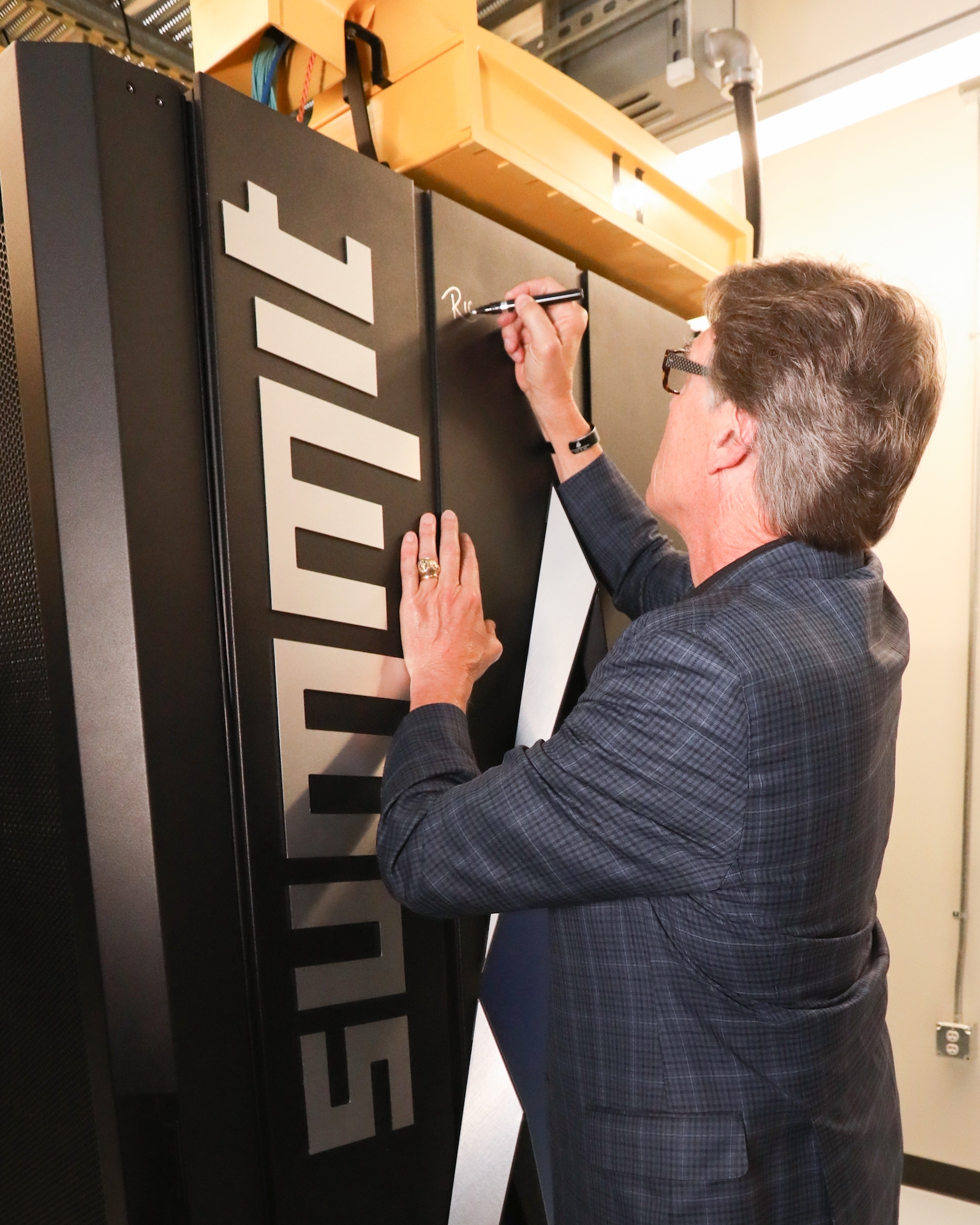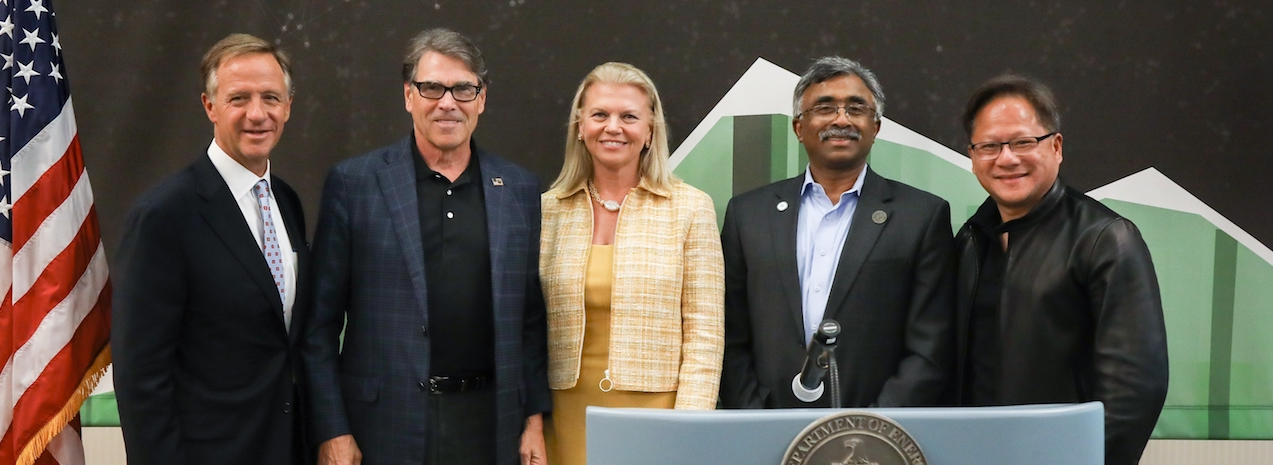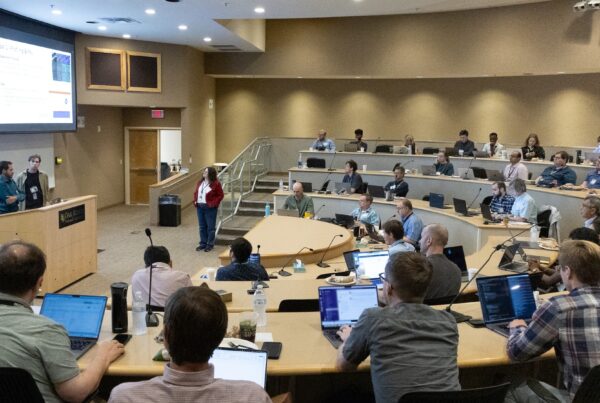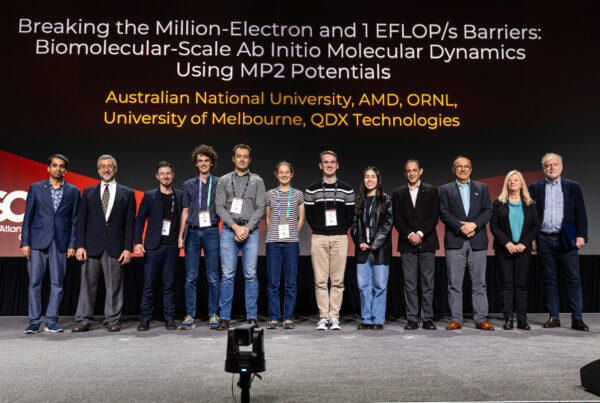The US Department of Energy’s (DOE’s) Oak Ridge National Laboratory (ORNL) launched the IBM AC922 Summit, the world’s most powerful and smartest scientific supercomputer, on June 8. Guests present to celebrate the announcement included US Secretary of Energy Rick Perry, Tennessee Governor Bill Haslam, and the CEOs of IBM and NVIDIA.

Secretary Perry high fives a group of children in the Court of Flags on June 8. Around 1,000 children and grandchildren of ORNL staff members attended Take Your Child to Work Day as part of ORNL’s 75th anniversary celebration weekend.
Held during ORNL’s 75th anniversary celebration weekend, the event coincided with ORNL’s Take Your Child to Work Day; many Oak Ridge Leadership Computing Facility (OLCF) staff members attended, along with some of their children and grandchildren. The OLCF, which houses Summit, is a DOE Office of Science User Facility at ORNL. Also attending the event were Johnny Moore, DOE site manager at ORNL; University of Tennessee President Joe DePietro; director of DOE’s Advanced Scientific Computing Research office Barb Helland; and representatives from Mellanox, whose high-speed interconnects enable high I/O throughput on Summit.
Under the high-performance computing industry standard of double-precision operations, Summit has a peak performance of 200 petaflops, or 200,000 trillion calculations per second, making it the fastest supercomputer in the world. Summit is so fast, in fact, that ORNL researchers have already broken the exascale barrier using what are called mixed-precision operations, which can boost performance for some science applications. Dan Jacobson, Wayne Joubert, and their colleagues used Summit to run their genomics code, clocking in at 1.88 exaops—nearly 2 billion billion mixed-precision calculations per second.
ORNL lab director Thomas Zacharia reflected at the event on the OLCF’s beginnings as the Center for Computational Sciences, founded in 1992, and described the transition from vector systems to massively parallel machines. Suited for an artificial intelligence (AI) workload, Summit is at the peak of innovation in high-performance computing today.
“Summit is going to accelerate discoveries, spur innovations,” Perry said, referring to the early science projects slated to run on Summit. Among these are ORNL researcher Gina Tourassi’s cancer surveillance project, Jacobson’s systems biology exploration, ORNL staff scientist Paul Kent’s work on materials, and ORNL computational astrophysicist Bronson Messer’s studies of the stars.
“It’s going to impact people’s lives,” Perry said. “This is about changing the world.”

Secretary Perry was the first to sign one of Summit’s cabinets on June 8 as part of the ORNL announcement event.
IBM chairman, president, and CEO Ginni Rometty spoke at the event, underscoring the roles that innovation, expertise, and trust played in the project. Aside from fine-tuning the IBM Power9 CPUs and NVIDIA V100 GPUs for AI applications, IBM and ORNL staff members had to engineer the ability to move a massive amount of data between the two types of processors at unprecedented speeds. In addition, they had to optimize much of the memory and storage of the processors.
NVIDIA founder, president, and CEO Jensen Huang said the new system is so capable that it can simulate a human brain, where each of the 100 billion neurons is modeled with 30 million instructions per second. “Summit is fast, but what Summit means is even more remarkable,” Huang said. “Summit is a magnificent scientific instrument and will attract the world’s great scientists.”
Zacharia capped the event with an unveiling of a plaque to recognize the day’s event, thus initiating a new tradition in the launch of ORNL supercomputers.
With Summit deployed, the OLCF is eagerly looking toward its next system, Frontier, which will debut in a few years as the center’s first exascale supercomputer.
“Summit is a milestone in a global race,” Huang said. “The prize of winning is the science, and surprisingly, when you win it, you share it with all of humanity.”
ORNL is managed by UT-Battelle for the Department of Energy’s Office of Science, the single largest supporter of basic research in the physical sciences in the United States. DOE’s Office of Science is working to address some of the most pressing challenges of our time. For more information, please visit https://science.energy.gov.






